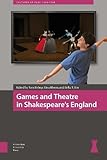Games and Theatre in Shakespeare's England / ed. by Erika T. Lin, Tom Bishop, Gina Bloom.
Material type: TextSeries: Cultures of Play ; 3Publisher: Amsterdam : Amsterdam University Press, [2021]Copyright date: ©2021Description: 1 online resource (332 p.)Content type:
TextSeries: Cultures of Play ; 3Publisher: Amsterdam : Amsterdam University Press, [2021]Copyright date: ©2021Description: 1 online resource (332 p.)Content type: - 9789048553525
- Games in art
- Games -- History
- Performing arts
- Cultural Studies
- Cultural studies
- Early Modern Studies
- Festivals, Theatre, and Performance
- Game Studies
- History, Art History, and Archaeology
- Literary studies: c 1400 to c 1600
- Literary studies: plays and playwrights
- Shakespeare
- HISTORY / Social History
- Drama, theatre, play, games, early modern
- 790 23
- GV1200
- online - DeGruyter
| Item type | Current library | Call number | URL | Status | Notes | Barcode | |
|---|---|---|---|---|---|---|---|
 eBook
eBook
|
Biblioteca "Angelicum" Pont. Univ. S.Tommaso d'Aquino Nuvola online | online - DeGruyter (Browse shelf(Opens below)) | Online access | Not for loan (Accesso limitato) | Accesso per gli utenti autorizzati / Access for authorized users | (dgr)9789048553525 |
Frontmatter -- Table of Contents -- Acknowledgments -- List of Abbreviations -- Introduction -- Part I -- 1. The Player’s Game -- 2. “The Madnes of Tenys” and the Commercialization of Pastimes in Early Tudor London -- 3. The Roll of the Dice and the Whims of Fate in Sixteenth-Century Morality Drama -- 4. “The games afoote” -- Part II -- 5. Playing with Paradoxes in Troilus and Cressida -- 6. Bowling Alone, or The Whole Point of No Return -- 7. Playing (in) the Streets -- Part III -- 8. The Moods of Gamification in The Tempest -- 9. Videogames and Hamlet -- 10. Shakespeare Videogames, Adaptation/ Appropriation , and Collaborative Reception -- 11. Shakespeare, Game, and Play in Digital Pedagogical Shakespeare Games -- Epilogue: Field of Play -- Index
restricted access online access with authorization star
http://purl.org/coar/access_right/c_16ec
This collection of essays brings together theories of play and game with theatre and performance to produce new understandings of the history and design of early modern English drama. Through literary analysis and embodied practice, an international team of distinguished scholars examines a wide range of games—from dicing to bowling to roleplaying to videogames—to uncover their fascinating ramifications for the stage in Shakespeare’s era and our own. Foregrounding ludic elements challenges the traditional view of drama as principally mimesis, or imitation, revealing stageplays to be improvisational experiments and participatory explorations into the motive, means, and value of recreation. Delving into both canonical masterpieces and hidden gems, this innovative volume stakes a claim for play as the crucial link between games and early modern theatre, and for the early modern theatre as a critical site for unraveling the continued cultural significance and performative efficacy of gameplay today.
Mode of access: Internet via World Wide Web.
In English.
Description based on online resource; title from PDF title page (publisher's Web site, viewed 01. Dez 2022)


